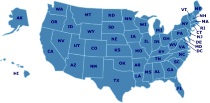Chemistry
From equipment to textbooks, websites to periodic tables, you'll find everything you need to successfully teach chemistry in your homeschool.
Things to See & Do in California
California Science Center
The California Science Center offers fun and informative permanent exhibits presented in interactive worlds. Through hands-on experiences, you'll learn about human inventions and innovations, the life processes of living things and more. Includes an IMAX theater, Air & Space Gallery, and special exhibits. Admission to the permanent exhibits is free. Located in Exposition Park in Los Angeles.
Chemistry Teaching Tips & Ideas
How I Teach a Large Family in a Relaxed, Classical Way: Science
Family style learning is a great way to tackle lots of different subjects, including science.
Chem4Kids
A great website for kids to learn about chemistry. Basic chemistry help and information with facts about matter, atoms, elements, the periodic table, reactions and biochemistry.
Chemistry Homeschool Curriculum
Christian Kids Explore Chemistry
These user-friendly, unabashedly Christian, one-year science curriculums for elementary students include teaching lessons, coloring pages, hands-on time, memorization lists, review sheets, creative writing assignments, and a supplemental book list. The Chemistry text is intended for grades 4-8, and includes such hands-on activities as making model atoms, breaking covalent bonds, and making gas expand. It also lists chemistry terms, notations, and rules. The conversational style gives students the basic information they need, making this an ideal first course in life science, especially useful for those following a classical approach.
Chemistry Activities & Experiments
ExploraVision
ExploraVision is a competition for all students in grades K-12 attending a school in the U.S., Canada, U.S. Territory or a Department of Defense school. Homeschooled students are eligible to enter. It is designed to encourage students to combine their imagination with their knowledge of science and technology to explore visions of the future. Teams of students select a technology, research how it works and why it was invented, and then project how that technology may change in the future. They must then identify what breakthroughs are required for their vision to become a reality and describe the positive and negative consequences of their technology on society. Winning ideas have focused on things as simple as ballpoint pens and as complex as satellite communications. The student teams write a paper and draw a series of Web page graphics to describe their idea. Regional winners make a Web site and a prototype of their future vision.
Featured Resources
As an Amazon Associate, we earn from qualifying purchases. We get commissions for purchases made through links on this site.
National Geographic Guide to the National Parks of the United States, Fourth Edition
Now in its fourth edition, the National Geographic Field Guide to the Birds of North America is the ultimate birder’s field guide. Sturdy, portable, and easy-to-use, it features the most complete information available on every bird species known to North America. This revised edition features 250 completely updated range maps, new plumage and species classification information, specially commissioned full-color illustrations, and a superb new index that allows birders in the field to quickl...
Name That Country Game
"Dear Pen Pal, Konnichi wa! We've been to see Mt. Fuji. Name my country! Sayonara, Michiko." Challenge your group with this fast-paced geography game, created in 1992 by Educational Insights, Inc. Everyone begins at the post office. Players twirl a finely printed spinner (built into the game board itself) to select one of 60 countries. If the player can correctly identify the country's location on the board's numbered map, he or she may advance along the path to the finish. Bonus moves are won b...
Pass Your California DMV Test Guaranteed! 50 Real Test Questions! California DMV Handbook
This book contains the 50 most common questions and answers to the California DMV Written Test. Written by a former DMV classroom instructor and test creator, this straight forward book tells you the most likely questions and answers that will appear on you exam. Typically, at least 70-80% of the questions you encounter will come from these high frequency questions. Pass your test today!
When Children Love to Learn: A Practical Application of Charlotte Mason's Philosophy for Today
Children want to learn and one of the best approaches to homeschooling is to meet their natural curiosity with support and understanding. Charlotte Mason's educational philosophy does just that. This book offers explanations of how to incorporate Mason's ideas into your teaching, leading to more success in learning and less frustration in the home education environment. This book is a great resource for those embarking on the homeschool journey, as well as being an invaluable resource for those ...
A Twaddle-Free Education: An Introduction to Charlotte Mason's Timeless Educational Ideas
Are you disappointed with dumbed-down reading material (“twaddle”) written for children? Do you wish for your children to feast their hearts and minds on noble ideas, fine art, and great literature? Are you hoping your children gain an appreciation of nature and a deep understanding of natural sciences? Most importantly, do you want your children to develop a lifetime love of learning? If you answered “yes,” you may discover a Charlotte Mason-inspired twaddle-free education is just what you’ve b...





